Silent heart attacks: Can you spot it?
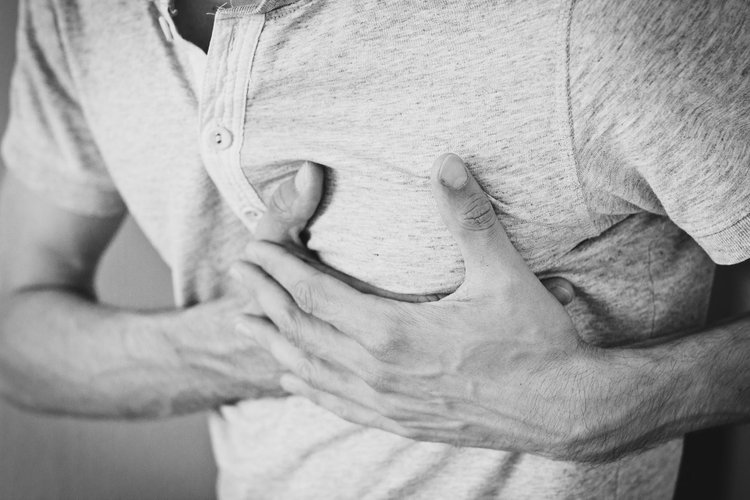
Before I started medical school, I always thought heart attacks are just as dramatic as we have seen in movie scenes, an old man clutches his chest, gasping for air before he falls to the ground. In reality, however, symptoms of a heart attack might manifest in a much subtle way. Imagine a silent heart attack slowly damages your heart bit by bit and you are totally not aware of it. Sounds scary huh?
So, what exactly is a silent heart attack? It does sounds atypical, is it not? When I was in medical school, I was taught to recognize the atypical symptoms of different kind of diseases. Anyway, as my professor once said, in order to identify an atypical symptom, one must first recognize the typical. Ya…I know it is boring, but please, just let me explain what a typical heart attack is.
So, a so-called typical heart attack (which is the kind of heart attack when it comes to our mind) occurs when blood flow in coronary arteries is blocked by the atherosclerotic plaque, which then impairs the oxygen supply to the heart muscle, possibly leaving irreversible heart damage.
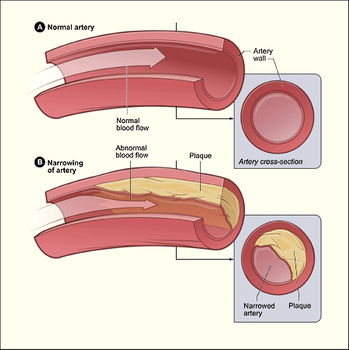
Based on the extent of obstruction in coronary arteries, there are three types of heart attack:
• Unstable angina
Severely but not completely obstructed, myocardial necrosis is not detectable
• NSTEMI (Non ST-segment elevation myocardial infarction)
Severely but not completely obstructed, myocardial necrosis is detectable
• STEMI ( ST-segment elevation myocardial infarction)
Completed obstructed, significant heart damage
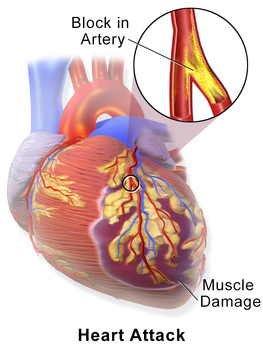
Among the three of them, STEMI happens to be the most serious type. Due to the total obstruction of coronary arteries, blood supply is completely cut off. Due to the depletion of oxygen and nutrients, heart muscle cells start to die slowly. The damaged area is more extensive and its symptoms usually manifest in a very unpleasant way.
Symptoms of STEMI include:
• Sudden chest pain
• Chest tightness
• Pressure as if elephant sitting across the chest
• Shortness of breath
• Pain radiated to back, neck, jaw, shoulders and left arm
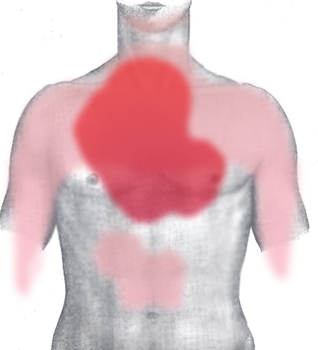
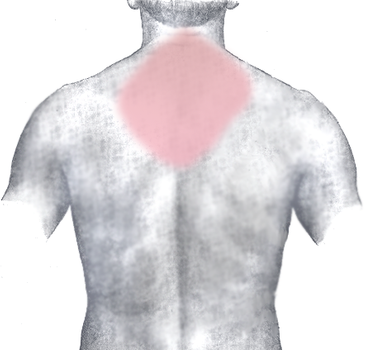
The dark red area is where the pain usually strikes us; the light red area, not so often.
Risk factor:
• Age: Males > 45 years old or females > 55 years old
• Diabetes mellitus
• Hypertension
• Hyperlipidemia
• Obesity
• Metabolic disorder
• Sedentary lifestyle
• Smoking
• A family history of heart attack

Silent heart attack, on the other hand, is pretty much the same thing, except its symptoms are not so typical. It could start slowly, then come and go over several hours; the patients usually feel mild pain or other no-so-specific symptoms, such as:
• Nausea
• Vomiting
• Stomach upset
• Unusual fatigue
• Weakness
• Cold sweat
• Sleep disturbances
As a result, many patients with silent heart attack might overlook their discomfort and it could take days, weeks or months before they come to the outpatient clinic to seek for medical help. Believe it or not, according to the American heart association, nearly half of all heart attacks are silent, and it is more common and fatal in women.
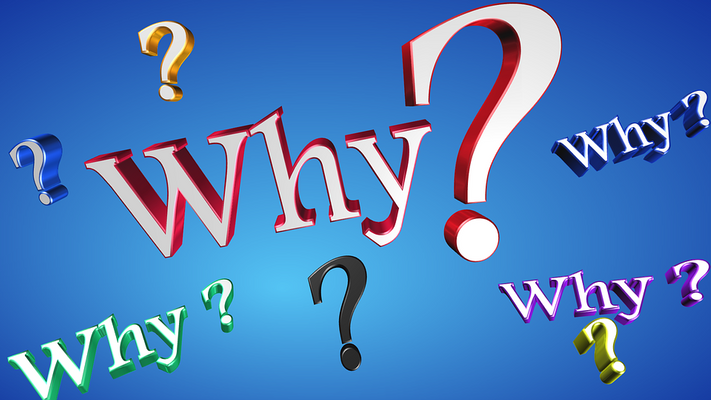
The reason behind this probably has to do with pain tolerance. A Norwegian study indicated that patients of silent heart attack possess higher endurance in a pain test. In this test, selected adults underwent a cold pressor test which they have to place their hands in ice-cold water at 3 degree Celsius up to 2 minutes. Electrocardiogram was used to differentiate their heart attack status. Those with silent heart attack endured the test much longer than the others and were less likely to quit the test. However, no previous study has examined the relationship between pain sensitivity and recognition of heart attacks. Therefore, more research needs to be done to find out what is really going on in silent heart attacks.
Since the patients of silent heart attacks usually possess higher pain tolerance and less sensitive to pain, they rarely feel anything wrong before it is too late. As a result, they did not receive proper treatment on time, and that usually puts them in poor prognosis and poor recoveries. Sometimes, if the heart damage is significant, complication might occur, and it is usually fatal.
Those complications are:
• Heart arrhythmia
• Heart failure
• Pulmonary edema
• Heart rupture
A typical heart attack often occurs suddenly, its life-threatening symptoms should be able to tell you right away how urgent it is to call an ambulance. The atypical silent one, due to its subtle nature, it would require us to take extra caution. The sooner you are treated, the greater the chances of your survival.
Can cough CPR saves your life?

I know, there were times when the social media told us cough CPR (cardiopulmonary resuscitation) could save you from heart attacks, well, this is so wrong. In fact, cough CPR is a procedure which is used to maintain adequate systemic blood supply in those who experience heart arrhythmia, not a heart attack, and it has to be conducted in cardiac catheterization laboratory under physician’s supervision. During this procedure, the patients were told to have a deep rhythmic forceful cough repeated 30-60 times every minute.

However, most of us are not capable of dimension jumping, whenever heart arrhythmia pays us a visit, there is really nothing much to do but to call for medical help immediately. Due to the nature of cardiac arrhythmia, the heart rates usually either too fast or too slow; sometimes, the rhythm also sort of irregular. As a result, the heart just didn’t contract properly, leading to the insufficient blood supply to the brain, it is just a matter of seconds before you lose consciousness and proceed to cardiac arrest, which the heart just stop pumping any blood.
Theoretically, if someone is having a cardiac arrhythmia and standing on the verge of fainting, by coughing forcefully and repetitively in the right rhythm, it shall increase the intrathoracic pressure to maintain the blood supply to the brain and buys him/her a few more seconds. In that case, he or she will have a chance to call for an ambulance or inform his/her family.
Nevertheless, cough CPR should be conducted under the supervision of a physician. Without a proper training to master its specific rhythm, the outcomes might just even worse. Not to mention if a heart attack is mistaken for cardiac arrhythmia. During a heart attack, the coronary artery is blocked, the blood supply is cut off, the heart muscle in the ischemic area starts to die, but the heart still continues to contract, the blood supply still goes on. So, there is no point to do the cough CPR. Instead, he or she should call an ambulance, sit quietly until the help arrives.
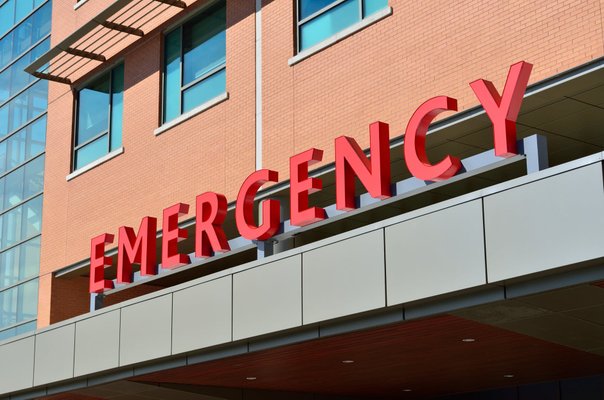
Usually, when a patient of such arrives in the emergency department, it is usually overwhelming. Investigations such as the following will be arranged in a speedy way:
• Check vital signs: Temperature, heart rate, breathing rate, blood pressure
• Set up an intravenous line: For fluid and drug administration
• Take medical history: Risk factor, drug allergy, etc
• Perform electrocardiogram (ECG), to find out what type of heart attack
• Arrange blood test to check full blood count, blood sugar, cholesterol level, BUN,
serum creatinine, coagulation profile, cardiac marker (troponin I or T), CK and CK-MB
• Chest X-ray: To rule out another life-threatening possibility, such as aortic dissection, cardiac tamponade, tension pneumothorax, pulmonary embolism

Management
• Bed rest: Try not to move around and exert stress to the heart
• ECG monitoring: To observe if the heart condition improve or exacerbate
• Oxygen: Adjusted high concentrated oxygen provided with a nasal cannula or face mask
• Antiplatelet agents: Aspirin (enhances the effect of thrombolysis, chew aspirin and swallow it for the maximal therapeutic benefit, if possible) and clopidogrel
• Analgesia:
->Sublingual nitroglycerin: For vasodilation, more blood in the artery, less stress and less pain to the heart, contraindicated if hypotension
->Morphine; To ease the pain + IV anti-emetic to cancel out the side effect of morphine (nausea/vomiting)
->If sublingual nitroglycerin and IV morphine do not improve the symptoms, gives IV nitroglycerin
->Sedation with small oral doses of lorazepam or diazepam if necessary
Once the patient is diagnosed with heart attack, reperfusion therapy will be arranged immediately. There are two common types of reperfusion therapy, which is thrombolysis and percutaneous coronary intervention (PCI).
Thrombolysis
By using a fibrinolytic agent (tissue plasminogen activator) to break down blood clot, early reperfusion can be achieved in most of the patient. However, some criteria must be fulfilled:
• The onset of symptoms must be less than 12 hours
• The patient must not have a brain hemorrhage, any other cerebrovascular disease within 12 months, ischemic stroke, recent head trauma, active internal bleeding, suspected aortic dissection and persistent blood pressure 200/120>mmHg
During the first 2 hours, the effect of thrombolysis is the best. However, PCI is preferred if:
• The patients fulfill one or more of the exclusion criteria
• The onset of the symptoms is already more than 3 hours
• The patient is having cardiogenic shock
Be that as it may, the practice of PCI is not so feasible, not even in the most developed country. Not every hospital has that equipment, expertise or facility to perform PCI. Therefore, whenever the patients fulfill the criteria of thrombolysis, and the fibrinolytic agent could be provided within the door to needle time (amount of time before a heart attack patient receive thrombolytic therapy upon entering the door of the hospital, which is 30 minutes), thrombolysis shall be used for reperfusion therapy.
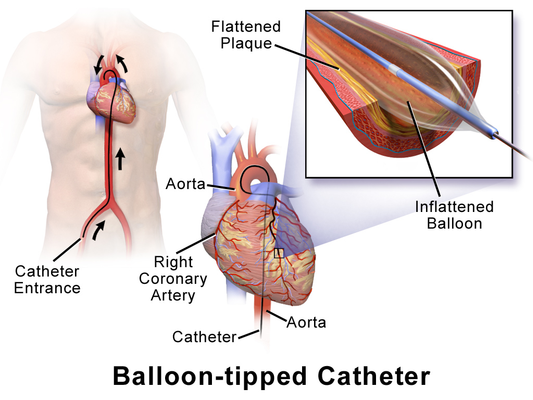
Percutaneous coronary intervention (PCI)
Compared with thrombolysis, treatment of PCI is much superior, not only it is more effective, the mortality of the patients also lower. Its door to balloon time (amount of time before a heart attack patient receives PCI upon entering the door of the hospital) is 90 minutes.
It is a less invasive procedure used to open up the obstructed coronary artery. Through the opening of cut on the femoral artery, a catheter is inserted into the bloodstream. A coronary angiogram will be used to localize the infarcted artery. After that, by using an extraction catheter, the thrombus is removed from the obstructed artery. Then, a balloon catheter with a deflated balloon is advanced into the narrowed artery to be inflated. Once the blood perfusion is restored, a stent will be deployed to keep the artery wide open.
The only downside of PCI probably is its low feasibility. Should the PCI fail to restore blood perfusion or it is not possible to perform PCI, coronary artery bypass graft (CABG) will be considered.
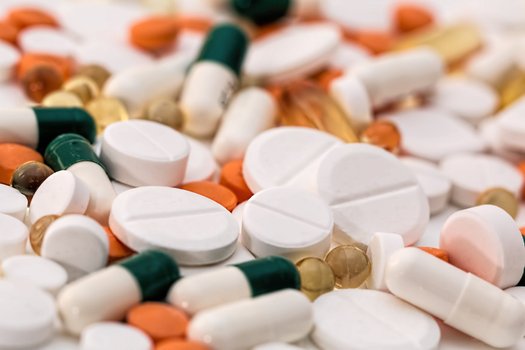
The following medication will be given after reperfusion therapy to reduce mortality from heart attack and improve survival:
Beta-blocker
• To slow down heart rate and decrease heart contraction force. Less workload, less stress, less oxygen consumption, more rest, better recovery
• However, it is contraindicated if the patients also have congestive heart failure, asthma, chronic obstructive pulmonary disease (COPD), high-grade AV block, severe peripheral vascular disease
Angiotensin-converting enzyme inhibitors (ACEI)
• It prevents progressive left ventricle modeling and sudden death, and hence improve the survival rate
• Angiotensin receptor blocker is an alternative if the patient intolerant of ACEI side effect (cough)
Statin
• To keep cholesterol in the acceptable level
• Should be given regardless of the patient lipid profile
Anticoagulant:
• Help prevent blood clots, works as a blood thinner
• Need to monitor activated thromboplastin time (aPTT) to control the bleeding tendency
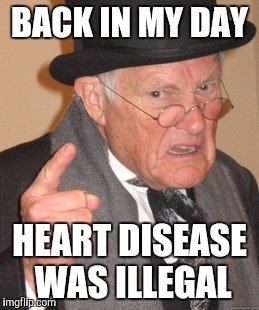
Heart attack is a bitch, some people survive it, and some do not. Sometimes, it screws up your life in just a few seconds, sometimes it spends a few months to mess with you. Whenever you suspect a heart attack, seek medical help immediately. Luck is not something you take for granted.
- Harrison's Principles of Internal Medicine, 18th Edition
- Sarawak Handbook of Medical Emergencies, 3rd Edition
- What are the signs of heart attack in a woman? Retrieved on 1st August 2018, from https://www.medicalnewstoday.com/articles/321528.php?sr
- Cough CPR. Retrieved on 1st August 2018, from https://www.heart.org/en/health-topics/cardiac-arrest/emergency-treatment-of-cardiac-arrest/cough-cpr
- Reperfusion Therapy. Wikipedia. Retrieved on 1st August 2018, from https://en.wikipedia.org/wiki/Reperfusion_therapy
Congratulations @darrenych86! You have completed the following achievement on Steemit and have been rewarded with new badge(s) :
Click on the badge to view your Board of Honor.
If you no longer want to receive notifications, reply to this comment with the word
STOPTo support your work, I also upvoted your post!